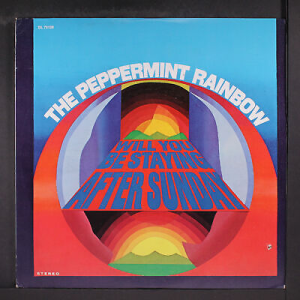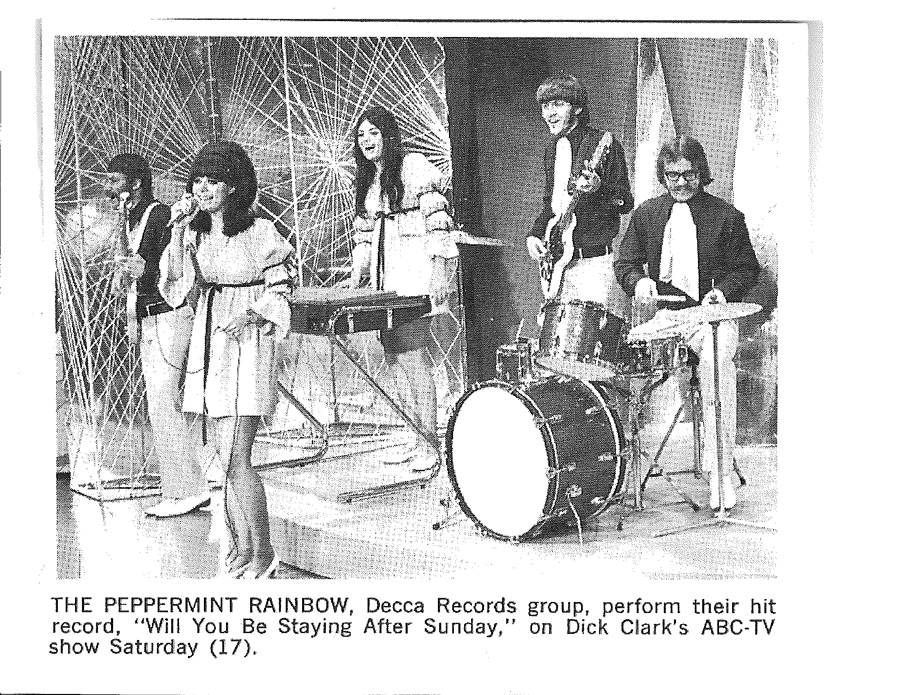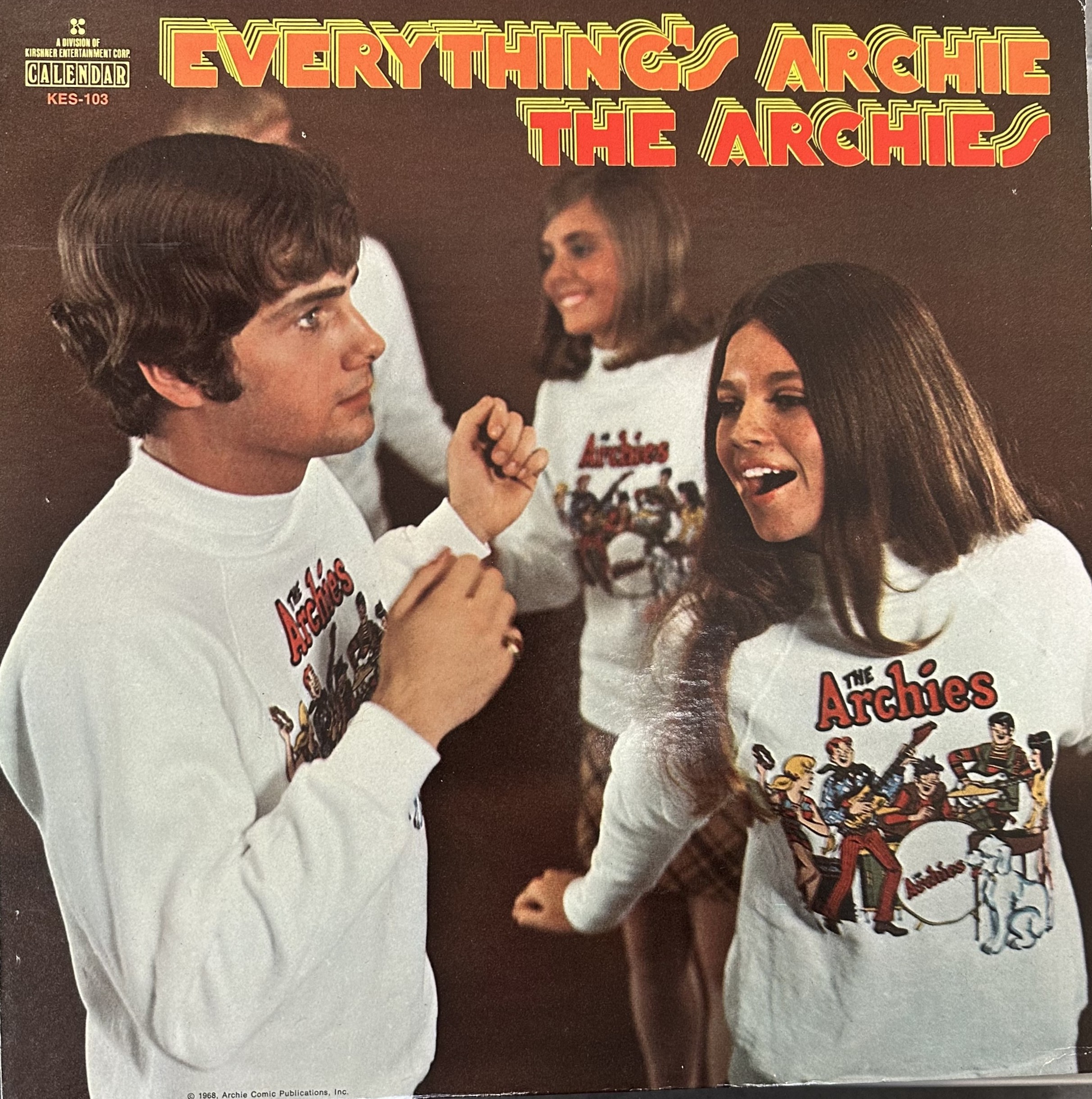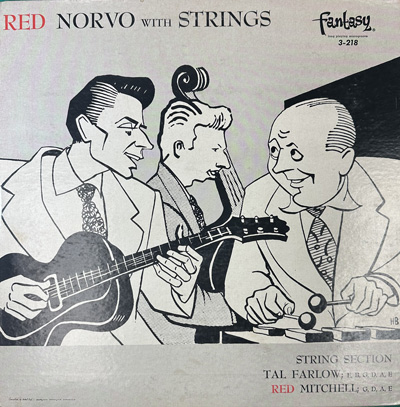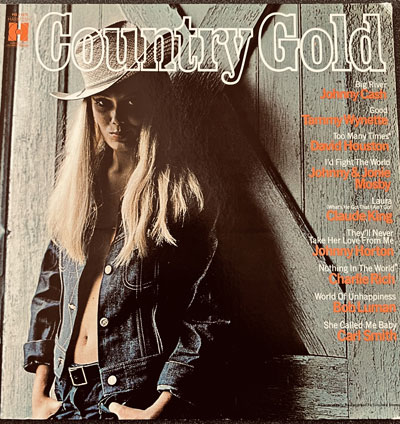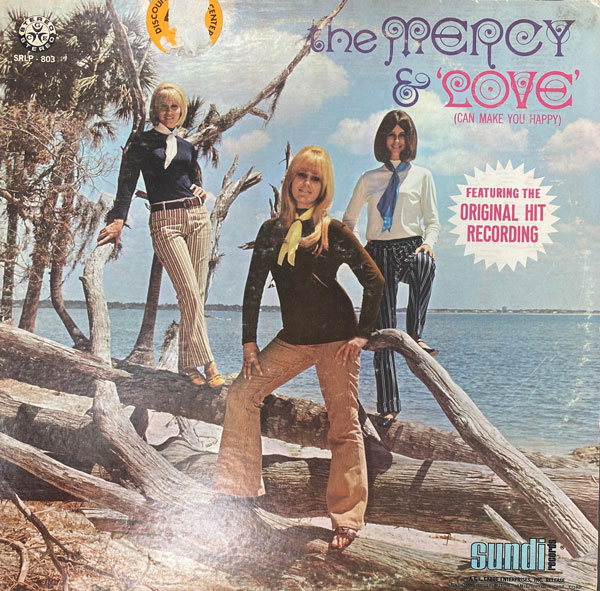As a child of the 60s, I heard some of the greatest rock and roll ever created, and the place I heard much of it was in the back seat of my mom's car. As I lived in Los Angeles, the number of AM radio stations that played rock and roll was vast, and therefore a lot of musical seeds were planted in my young brain. Most of those seeds took root and eventually became vital parts of my LP collection. However, a few of the lesser heard and lighter rocking seeds went dormant and became unidentified musical fragments. Every now and then one of those fragments floats to the surface, only to get returned to my mental filing cabinet. However, just as randomly, one of those unidentified fragments will rise to the surface as a complete song, and thus it becomes a living, breathing part of my musical library. One such song is the title cut to the only album made by a Baltimore band called The Peppermint Rainbow.
The song "Will You Be Staying After Sunday" must have entered my head in 1969, as it was a hit that year. However, unlike songs by big names like The Beatles, Crosby Stills & Nash, and Motown in general, the song faded into oblivion. I would have to wait four decades to hear it again. That occasion came about twelve years ago, and the music wasn't blaring from my mom's car radio. On that particular night it came from a friend's high end system, fed by a Goldmund turntable and a Dynavector cartridge. What a great moment that was. The song approached me like an old friend who just wanted to reconnect. However, for reasons beyond my control, my copy of the album, Will You Be Staying After Sunday (Decca DL 75129), would require an additional ten years before it could enter my LP collection. I found the album at my local Goodwill in 2021.
So, what exactly is a Peppermint Rainbow? They were a talented pop-rock quintet from Baltimore that, like The Association, The Fifth Dimension, and the Mamas & Papas, excelled at the art of harmony singing. So much so that it's easy to overlook the quality of their musicianship. The first thing that one notices is their lead vocalist, Bonnie Lamdin. Bonnie has a marvelous mezzo soprano voice that sounds like a 80/20 mix between Spanky McFarland and Grace Slick. It certainly didn't hurt that Bonnie sounded like a dead-ringer for Spanky on "Will You Be Staying After Sunday." The song was their biggest hit. The band's music was produced by Paul Leka, who was a proven hit maker. Paul knew how to make bands sound catchy, but he also knew how to smother a band's musical chops with his heavy-handed overlay of strings, winds, and studio musicians. Despite Leka's dense production, Bonnie's vocals float above the large array of strings, percussion, and background vocals. The same goes for the band's superb drummer, Anton Corey, whose tight musicianship and tom-tom fills are one of the band's most notable trademarks. Corey also had a fine voice, as did Bonnie's sister, Pat, who also played a Farfisa electric piano. Guitarist Doug Lewis and bassist Skip Harris (194?-2017) also sang.
The album opens with the it-ought-to-be-more-famous title track. Despite the bittersweet lyrics, it's the soaring merry-go-round-like display of musical color that sweeps me off my feet every time I hear it. It has strings. It has brass. And it has groovy tambourines. The song's irresistible introduction starts with seven seconds of what are essentially Bonnie and Pat's a capella vocals, with overdubbed strings. This is quickly followed by Aton Corey's trademark drum fills, and then you're fully immersed by the sound of the entire band, and Paul Leka's masterful (at least on this cut) production. Check it out, and don't be too surprised if you recognize it.
The second cut is a lightweight but fun cut called "Pink Lemonade." In some circles it's considered a soft-psych classic. I kind-of like it, but I kind-of can do without it as well. The band had very little to do with its creation, as it's little more than one of Leka's studio concoctions. The two minute and six second song utilizes what sounds like the male vocal portion of the band in multi-layered form, backed by strings and woodwinds. This song was the B-side of their first single. I prefer an earlier version recorded by The Five Americans with lead singer Michael Rabon.
Side one closes with their second biggest hit, "Don't Wake Me Up In The Morning, Michael." Again, the sad lyrics are overshadowed, but not quite as much as with the title cut. I didn't like it the first time I heard it, but that's changed. The music is full of fantastic colors, courtesy of Bonnie's superb lead vocals, with vocal help from Pat. It's basically a second version of the title cut, which for me is awesome, since the title cut always leaves me wanting more and more of the same. I can't overstate the good quality of Bonnie's lead vocal, the tightness of the band, and, of course, Leka's skillful production. Whether you hear it as their second best song, or something equal to the title cut, the song is essential to understanding the band's magic.
Side two opens with "Walking In Different Circles." As the title suggests, it's a bittersweet song about a failed relationship. It's also the A-side of their first single, which I believe was released prior to the LP. Unlike the other somewhat sad songs, this one actually sounds a little sad, but it's also very enjoyable. The main feature, or better said, the main feature outside of Leka's winds and strings arrangement, is Bonnie's double-tracked voice. There is a well-performed alternative version of this song, released the same year, from the same label. That version is by another east coast group called The Elves. The frontman for The Elves, with the sweet tenor voice, was none other than the man from the silver mountain, Ronnie James Dio. Trust me when I tell you that the young Dio sounds nothing like the Dio that we all know.
I really like the third cut on side two. It's the good old classic "Green Tambourine," and the singer is the band's drummer, Anton Corey. To be honest, neither the Lemonpipers nor The Peppermint Rainbow played instruments on this cut. The song, with music by Paul Leka and lyrics by Shelley Pinz, was always created from pre-recorded backing tracks by a group of unknown studio musicians. (Just add a singer and you have a hit single!) Both versions use the same exact backing tracks, but there is a significant difference between them. Anton simply sings the song better than the Lemonpipers' Ivan Brown, and the sound, for unknown reasons, is much better on the Peppermint Rainbow's version. Go ahead and call this cut a cheap shot. A , and that works just fine for me. For audiophiles, this is the demo cut.
I love the closing cut. It's called "I Found Out That I'm a Woman." It's a catchy celebration of happiness and love, and it sounds good, too. The song uses the same architecture as the title cut, including Anton Corey's signature drum fill. Another great feature is the fact that there is no reverb on Bonnie's vocals, so you can really hear the uniqueness of her voice. Although she is double-tracked, the clarity of this cut really lets you examine what this band was all about. It's a great listen and a great closing to a fun and forgotten album from the very end of the 60s.
I had the once-in-a-lifetime opportunity to speak to Bonnie Lamdin Phipps on the phone. She answered my questions, and she surprised me by singing. Nice! Her pipes are intact, and sound ready for action. I wonder how often she sings these days.
According to Bonnie, the band did not perform original material. With such talent bubbling within them, I can't help but wonder what they could have been, or what they could have composed, if they had used a different producer, one who would have actually nurtured their talent. The Peppermint Rainbow had a unique presence. I felt it when I heard it on my friend's audio system, and I feel it now.
I need to be really honest with myself and my readers. When I focus my attention on a record, as in long enough to write about it, I tend to fall in love with it. Due to the intense time that I've spent with this music, I'm currently infatuated with it. Trust me, there's much to be in love with. Having said this, Paul Leka's production is downright smothering. As much as I know that there's a good band with good voices behind Leka's thick curtain of strings, winds, and percussion, it's very hard to determine how much of the music's magic is from the band, and how much of it is from Leka. Who the heck knows what kind of a record they would have made had they, for example, followed their friends, The Fifth Dimension, back to Los Angeles? My prediction is they would have sounded more exposed, folkier, and the songs would have a very different feeling.
The album's sound is not quite in the demo department, but it's definitely good. Thanks to the excellent tuning of Anton's drums, the bass, at times, can be solid and punchy. The clarity of Bonnie's voice varies from cut to cut, and I found it was clearest on the closing cut. "Green Tambourine,'' for reasons that we will never know, has excellent sound, a sound that the same exact tape didn't have a year earlier on the otherwise excellent sounding debut album by the The Lemonpipers. (Buddah BDS 5009).
Looking at what I've written, I'm surprised by the length of my document. And I didn't even discuss the band's history. Their history is well documented elsewhere, so I stuck to the music, which nobody has discussed in better detail than I have. I find it interesting that while the band scored success with their singles, their one and only LP didn't chart very well. I've always been an LP-centric music collector, so when I read that they only found success through their singles, I searched for the reasons why this happened. For two years this band worked their tails off to keep their brand before the public's eye. They were on game shows, talk shows, and their songs were on the radio, so what's up with the poor album sales? It's plain to see that the LP's artwork is cheesy. A photo of the band should have been on the front of the jacket. We do get a photo, but it's on the back of the jacket, but oh my, they're all wearing the same shade of blue. The ladies look great in their short dresses and go go boots, but the guys look a little goofy with their matching blue slacks, black shirts, white shoes, and matching ascot ties. This is not a rock and roll look. Oh well. Not all album jackets are as timeless as the music they contain.
What more is there to say? This is not essential rock and roll, but if you're looking for a really good time, this record will provide it. I'm really glad to offer it a space in my record collection.




